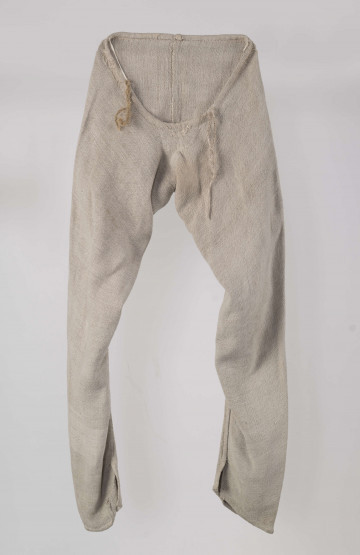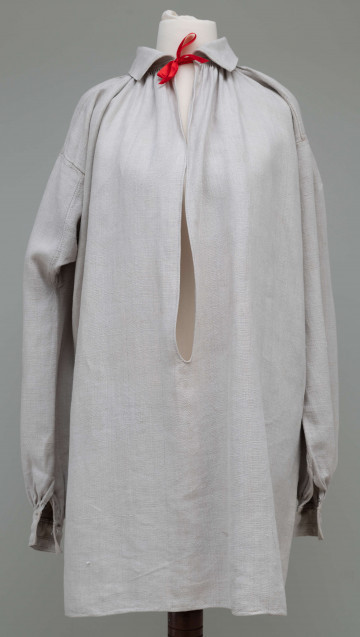
Hemp trousers `skośniaki`
1850 — 1900
National Museum in Lublin
Part of the collection: Folk craft of the Lublin Region (19th/20th c.)
A leather bag, called ‘kalita’, was carried by men from the Biłgoraj region. It was made of cowhide tanned in brown with linen lining. It was hand-made and shaped like a horseshoe turned with the rounded side down. It consists of three parts: the main bag, the flap and the strap. The top is covered by a flap giving it a slightly convex shape. At the top on both sides are sewn-on leather ears decorated at the bottom with leather tassels. Brass rings are threaded through the ears, to which an adjustable leather strap is attached for carrying the bag over the shoulder. The flap is decorated with embossed ornaments with floral and geometrical motifs. In the upper part, between the separated straps, small circles are embossed with a special stamp, creating the ornament – two circles are arranged next to each other, of the other two, one is nailed on top, the other one on the bottom. This pattern is repeated along the entire length in two rows, with a further three forming circles arranged close together in a row. The lower part of the flap is filled with a floral pattern made of circles using the same stamp. In addition, there are diagonal lines that intersect. The edge of the flap is also embossed with small circles, and a narrow strip of leather is sewn, punched to form a decorative fringe. Such bags were made by leatherworkers and sold at local markets or fairs, mainly to wealthy men. Less wealthy people made their bags from bast fibres, called 'kobiałki'.
This bag was worn at the back on the left side, with the strap resting on the right shoulder. It was taken on a long journey, for example, to a feast, a wedding or a fair. Food such as bread and bacon and a bottle of drink were kept in it. It also held a knife, a leather tobacco pouch, a pipe, a flint and a snuff box made from an ox's horn.
Author / creator
Dimensions
cały obiekt: height: 27 cm, width: 22 cm
Object type
bag
Technique
sewing
Material
natural leather
Creation time / dating
Creation / finding place
Owner
The National Museum in Lublin
Identification number
Location / status

1850 — 1900
National Museum in Lublin

1850 — 1900
National Museum in Lublin

1890 — 1910
National Museum in Lublin
DISCOVER this TOPIC
Castle Museum in Łańcut
DISCOVER this PATH
Educational path